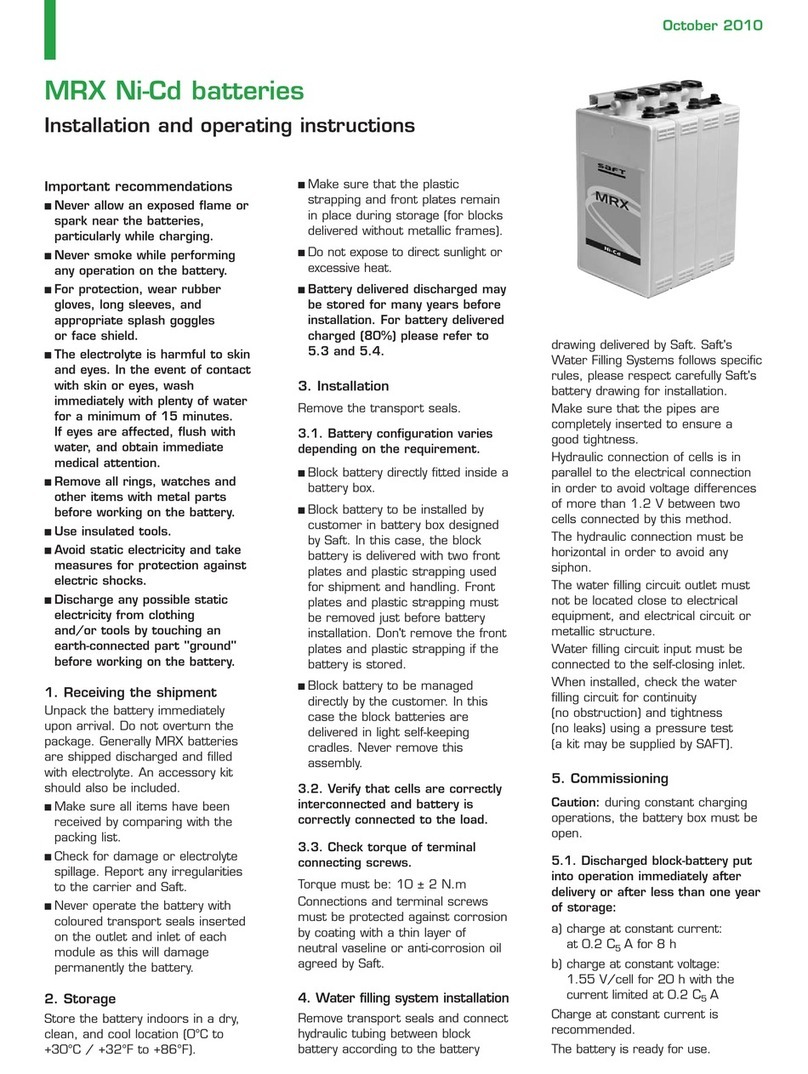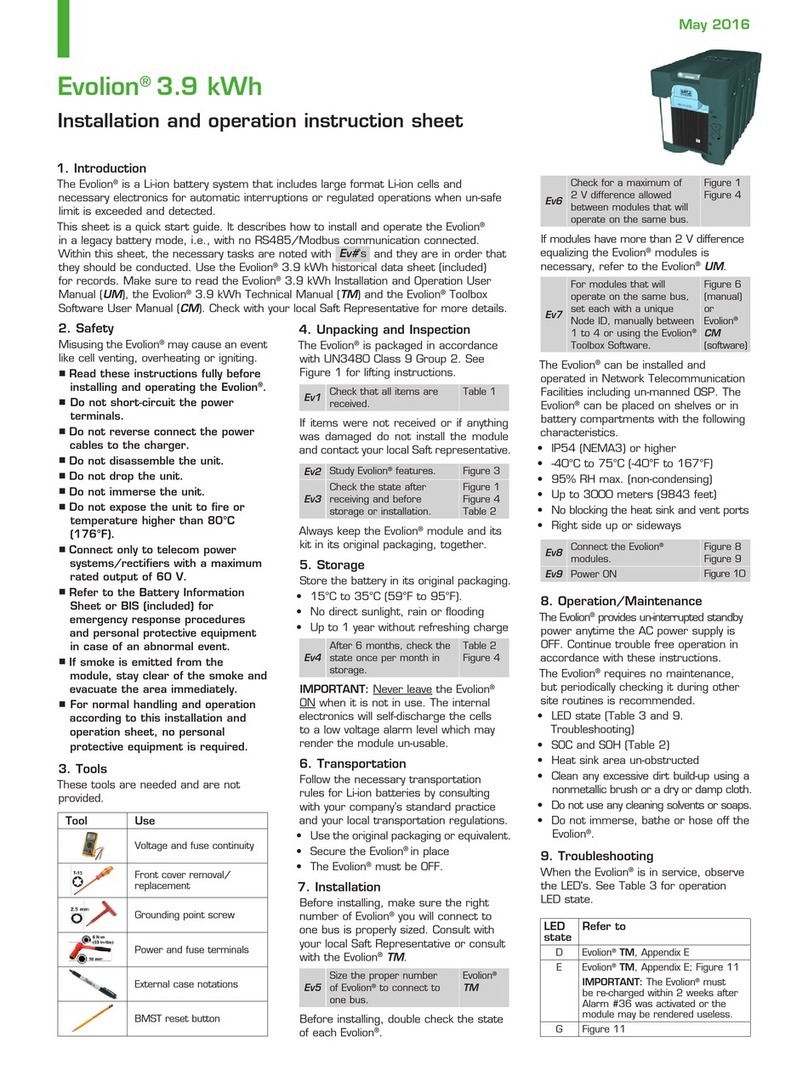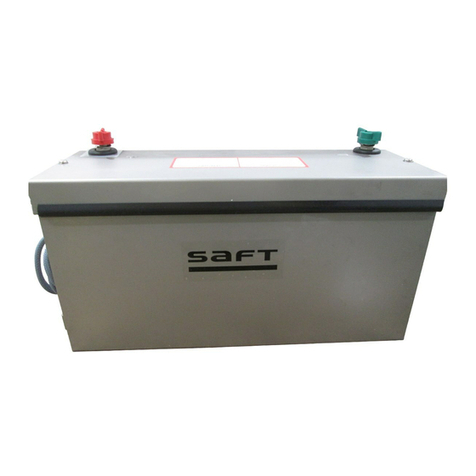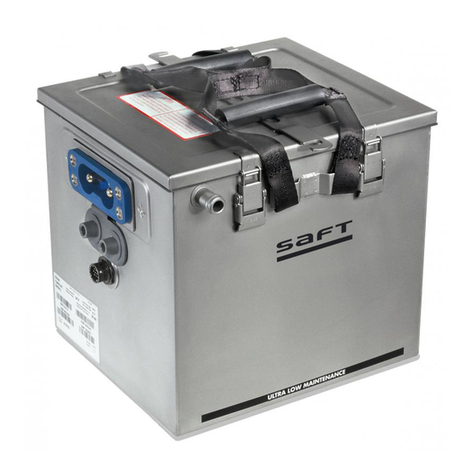Saft Evolion 2.1 kWh User manual

SOC / SOH button
(State of Charge / State of Health)
LED’s
RJ45 Jacks
ON/OFF
button
February 2015
Evolion® 2 .1 k W h
Installation and operating instructions
1. Safety
Make sure to study and follow all
instructions. Misusing the Evolion®
2.1 kWh may cause it to overheat
or ignite.
Do not short-circuit the power
terminals.
Do not reverse connect the
power cables.
Do not disassemble the unit.
Do not subject the unit to excessive
vibrations or drop the unit.
Do not immerse the unit.
Do not expose the unit to fire or
temperature higher than 100°C
(+212°F). It may cause the
cell safety vent to open which
renders the unit inoperable.
Use only in Telecom power
systems with a maximum rated
output of 60 V.
Refer to the Battery Information
Sheet (included) for emergency
response procedures.
2. Important recommendations
If smoke is emitted from a unit, stay
clear of the smoke and evacuate
the area until the smoke clears.
Refer to the Evolion® 2.1 kWh
Technical Manual for functional
details.
See Figure 1 for operator interface
features.
3. Unpacking and inspection
When shipped, the Evolion® 2.1 kWh
is packaged in accordance with
UN3480 Class 9 Group 2.
Unpack and make sure all items
were received. Table 1 summarizes
the standard kit.
If items were not received or if
anything is damaged contact your
local Saft representative.
If a long storage is planned (more
than 6 months), check and note the
SOC (State of Charge) according to
In these conditions, the Evolion®
2.1 kWh can be stored for up to 1
year from the manufacturing date.
Make sure the unit is switched
OFF during storage. When OFF,
the unit is in sleep mode. In sleep
mode, no voltage is present on the
terminals and the internal electronic
consumption is very low.
NOTE: The Evolion® 2.1 kWh unit will
periodically and automatically wake-up
to record its state and to initiate cell
balancing if necessary.
IMPORTANT: If the unit is left ON,
it may over discharge in less than 3
weeks and render the unit inoperable.
It is mandatory to check the SOC,
every 6 months, while in a long storage
period. See Figure 3 and Table 2.
If the Evolion® 2.1 kWh is stored at a
low SOC for too long, it may eventually
over discharge and render the unit
inoperable.
To conduct a maintenance charge:
• Connect according to Section 6
• Make sure the set-point voltage on
the rectifier is 56.0 V +/- 0.5%
• Charge for a total time according
to the available charge current
(see Table 3)
Figure 1 - Evolion® main front access
Figure 3 - Checking SOC (State of Charge)
• For SOC, push and hold for 3 s or less
and observe the LED’s.
Figure 2 - Accessing the unit
4. Storage
Store the battery in its original
packaging and in typical warehouse
conditions. The temperature should be
between 15°C to 30°C (59°F to 86°F).
Table 1 - Standard items in Evolion®
2.1 kWh kit (771473-XX)
Figure 3 and Table 2. A hole in the
packaging allows you to access the
unit without removing it from the
box. Refer to Figure 2.
This will help to plan the next
refreshing charge.
Keep Evolion® 2.1 kWh in its original
packaging for continued storage or
for transportation.
Part No Qty
781626 Evolion® 1
771285 Fuse, spare 1
780680 Power cable for positive
terminal (1 meter length) 1
772517
(Note 1)
Power cable for negative
terminal (1 meter length) 1
772518
(Note 1)
Communication cable
(1 meter length) 1
773455 RJ45 resistor cap 1
Table 2 - SOC (State of Charge) LED legend
Amps
per unit
Charging
time
Amps
per unit
Charging
time
36h 50 min 12 1h 42 min
45h 7 min 15 1h 22 min
54h 5 min 18 1h 8 min
63h 25 min 20 1h 1 min
82h 33 min 25 0h 49 min
10 2h 2 min CL mode 5h 7 min
Table 3 - Maintenance charge time
-XX: refers to the parameter file variant
Note 1: The cable Part N° varies according to heat
shrink color and cable color
*Note 1: CL = current limit mode, use a charge
current less than IMR to avoid CL mode charge.
See Evolion® 2.1 kWh Technical Manual for more
details.
SOC LED
(LED steady for 5 s)
Minimum SOC ≥75% ≥50% ≥25% <10%
Maximum storage time
(at less than 30ºC)
19.5
months
12.5
months
6.5
months
schedule
maintenance
charge
immediately

Power terminals M6
Heat sink Grounding point M3
Handle
Handle
Unit 1
Unit 1
bus
bus
bus
bus
Unit 2
Unit 2
Unit 3
Unit 3
Unit
n
Unit
n
Emergency vent ports
+
+
+
+
+
+
+
+
+
+
-
-
-
-
-
-
-
-
-
-
5. Transportation
Use the original packaging or
equivalent. Follow the necessary
transportation rules for Li-ion
batteries by consulting with your
company’s standard practice and
your local transportation regulations.
Secure the Evolion® 2.1 kWh to prevent
violent shock and other items from
falling onto it. The Evolion® 2.1 kWh
must be OFF during transportation.
6. Installation
See Figure 4 for Evolion® 2.1 kWh
features.
Pin 1 RS485+
Pin 2 RS485-
Pin 3 Ground (isolated from power terminals)
Pin 4 Wake up (ground referenced)
Pin 5 Reserved
Pin 6 Reserved
Pin 7 Dry contact alarm output
Pin 8 Dry contact alarm output
IMPORTANT: A reverse connection
on the power terminals may cause
an internal fuse fault. See Section
10 if replacing the fuse is necessary.
Connect communication
See Table 4 for RJ45 jack pin
assignments.
Table 4 - RJ45 pin assignments
Both RJ45 jacks are interchangeable
and can be used to plug either the
communication cable (772518) or
the RJ45 resistor cap (773455).
To access the dry contact alarm
signal, use pins 7 and 8. Both minor
or major alarm signals are reported
and the default state of the pin is as
follows:
CLOSED = ALARM/power down
OPEN = NO ALARM
Use the communication cable
provided. See Figures 7 and 8.
Make sure to conduct an
Evolion® 2.1 kWh Installation and
Commissioning (I&C) prior to
startup. Setting a unique node
ID (default = 1) for each parallel
connected Evolion®is necessary in
order to communicate using the
Saft Evolion® Toolbox software during
operation.
IMPORTANT: Never connect the
power terminals in series with other
Evolion® 2.1 kWh units. The Evolion®
2.1 kWh may be damaged and
rendered inoperable.
IMPORTANT: Parallel connecting can
be done as long as the total system
discharge current never exceeds
130 A (5 kW at 42 V) continuous.
In this case paralleling any number of
units is allowed.
Make sure to never parallel connect
Evolions that have more than 2 V
difference between the modules.
Equalizing the voltage by charging or
discharging modules separately may
be necessary. To check the open
circuit voltage when disconnected,
press the ON/OFF button for at least
2 seconds and measure the voltage
at the terminals. Make sure to turn
the unit OFF by pressing the ON/OFF
button for at least 4 seconds.
The Evolion® 2.1 kWh limits its
own current with a built in charge
regulated circuit. However, starting
up the Evolion® to avoid the charge
regulated mode is important to avoid
a possible internal fuse fault.
Make sure to switch off the battery
breaker(s) before connecting Evolion®
2.1 kWh power terminals to the
power bus.
The Evolion® 2.1 kWh power terminals
can be connected to systems with a
positive ground, a negative ground or
a floating ground system.
In order to prevent reverse connections,
make sure to measure and note the
polarity of the power bus cables.
Never block the heat sink.
Do not obstruct the emergency
vent ports.
Install in environment with IP55
(NEMA3 outdoor) or higher
protection index.
95% maximum humidity
(non-condensing)
Overall installation steps
(details follow):
1. Connect power
2. Connect communication (optional)
3. Startup
Required tools
• 10 mm socket (for terminal)
• Multimeter (60 Vdc, ohms)
• Flat screwdriver (for cover removal)
• 7 mm socket (for fuse)
• Torque wrench (insulated)
Connect power
Always connect the Evolion® 2.1 kWh
using the provided cables in order
to balance the resistance in each
branch. See Figures 5 and 6 for power
connections schematics and options.
Figure 4 - Evolion® 2.1 kWh features
(oriented upright with front and back view)
Figure 6 - Parallel connecting Evolions
OPTION 1 - For any
number of parallel
chained Evolions,
take off the power
bus connection
at the end of the
parallel connected
system. This is the
best way to balance
the resistance of
each.
NOTE: Can only be
used when the total
continuous bus
current is less than
or equal to 63 A.
OPTION 2 - For any
number of direct
connected Evolions,
using the same
length of cable
for each will make
sure to balance the
resistance.
Figure 5 - Connecting to terminals
• Only use the terminal bolts, washers,
terminal protectors and cable lugs
provided.
• Terminal bolt torque = 6 N.m (53 in.lbs)

Application:
• Dry contact (pin7 & pin8)
• RS485 bus (pin1 & pin2)
• Wake up signal (pin3 & pin4)
Customer provided cable
Application:
• Dry contact (pin7 & pin8)
• RS485 bus (pin1 & pin2)
• Wake up signal (pin3 & pin4)
Customer provided cable
Install RJ45
resistor cap
on end
module
Saft p/n 773455
Install RJ45
resistor cap
on end
module
Saft p/n 773455
Parallel connected
RJ45
Saft p/n 772518
Startup
Table 5 - Rectifier output settings
Table 6 - Operating LED legend
Note: Refer to 10. Troubleshooting if ABNORMAL
LED is active.
To shutdown the Evolion® 2.1 kWh
when connected to the application:
• Turn OFF the battery output breaker.
• Push the Evolion’s ON/OFF button
for at least 4 s.
When the Evolion® 2.1 kWh is OFF,
the LED’s are inactive.
7. Operation
The Evolion® is a “smart battery”
and will only allow safe operation.
If a key operating parameter is
exceeded, the Evolion® 2.1 kWh will
automatically interrupt or restrict
its operation until the key operating
parameter is back within acceptable
limits. In this case the alarm will be
reset and operation will continue
normally. Some alarms are only
resettable by the BMST reset
button or by sending a BMST reset
command on the RS485/Modbus
communication bus.
The Evolion® is an RS485/Modbus
slave. Any user configured RS485/
Modbus master equipment can
communicate with the Evolion®
2.1 kWh. See the Evolion®
communication user manual for
more details.
The Evolion® 2.1 kWh is equipped
with an internal heater. It operates
as needed in charge and discharge
mode of operation.
During operation, the LED’s are
active and indicate the Evolion’s
status. See Table 6.
Charging
Make sure that output of the
rectifier is set as 56.0 V ± 0.5%.
It must be set higher than 49.0 V to
allow cell balancing during re-charge.
Temperature Compensated Voltage
(TCV) should be disabled. The Evolion®
is not harmed by TCV control but the
available capacity will be decreased by
10% for every 1 V below 56.0 V.
• When Evolion® 2.1 kWh is used
in “floating operation”, for which
re-charge time is not critical, the
charge current can be limited to
16 A per Evolion® module.
• When Evolion® 2.1 kWh is used in
“cycling operation” the maximum
current will depend on the operating
temperature. Refer to Table 7.
• If the maximum allowed charged
current (IMR) is exceeded, the
Evolion® 2.1 kWh will automatically
regulate its own charge current by
switching to regulated charge. In
that case, the charge can last 24 h.
To start up the Evolion® 2.1 kWh
when connected to the application:
• Switch ON the rectifier/breaker
output.
IMPORTANT: Do not use the ON/OFF
button to switch ON the Evolion® 2.1
kWh when it is connected the power
bus. This may cause a fuse fault.
When the Evolion® 2.1 kWh is ON,
the LED’s are active indicating its
operational status (see Table 6).
The Evolion® 2.1 kWh will accept
charge current only when the
temperature is above - 30°C and
below +75°C (- 22°F and +167°F).
Discharging
The Evolion® 2.1 kWh will discharge
above - 30°C and below +75°C
(- 22°F and +167°F). The maximum
allowed discharge current is a
function of temperature.
IMPORTANT: If an Evolion® 2.1 kWh
is subjected to more than 130 A
(5 kW @ 42 V) of continuous
discharge current, a fuse fault will
occur. See Section 10 for fuse
replacement.
The Evolion® 2.1 kWh will continuously
discharge until one of the following is
encountered.
• The rectifier output power returns,
or
• The battery reaches the minimum
set SOC (0% by default), or
• No discharge current is present
for a set time duration (default is
0), or
• The ON/OFF button is pushed for
at least 4 s, or
• The maximum allowed discharge
current is exceeded, or
• The low voltage disconnect is
reached (default is 42.0 V).
When the end of discharge is
encountered due to a low end
voltage, the Evolion® 2.1 kWh will
eventually go into sleep mode when
the a low cell voltage is reached.
IMPORTANT: After the end of
discharge to 42 V, the Evolion®
can remain in sleep mode for a
maximum of 14 days. If re-charge
does not begin within this time,
the Evolion® 2 .1 k W h may be over
discharged due to its internal self-
discharge. If over discharged, it will
not startup and will indicate a major
alarm that is not resettable. The unit
will need to be replaced.
Figure 8 - Communication connecting
with parallel modules
Figure 7 - Communication connecting
with one module
NORMAL
slow blink Floating
fast blink Charging
steady Discharging
ABNORMAL
steady Low health
steady Warning
steady Alarm
# Type Setting
a. Single level voltage 56.0 Vdc ± 0.5%
b.
Temperature
compensated
voltage control
Disabled or turned OFF.
c. Maximum
re-charge current
See Table 7 (to
manage thermal
behavior)
d. Ramp in voltage/
current (soft start)
When the AC powers
ON, output voltage/
current should ramp up
to single level voltage
over at least 1 minute.
e. Default rectifier
output voltage
When AC powers ON,
if the rectifier controller
is not available or
working, make sure to
set the default rectifier
output voltage to 46 V
maximum.
f. Low voltage
disconnect (if used) 45 Vdc ± 1%
Cycling Frequency Maximum allowed
Amps per Evolion®
(Note 1)
More than 4x per day 16
3x to 4x per day 21
2x to 3x per day 24
1x to 2x per day 32
Less than 1x per day Less than IMR
*Note 1: The re-charge current can never be above
IMR to avoid charge regulated mode of operation.
Make sure to use the lowest value.
Table 7 - Maximum re-charge current
to manage thermal behavior of Evolion®
2.1 kWh

Push reset
button with a
pointed object
Figure 10 - Replacing a fuse
•Remove fuse cover by inserting, on either
side, a flat head screwdriver and twisting.
•Measure continuity. If good continuity,
the fuse is good. Re-install the cover.
•If no continuity, remove and replace
the fuse using a 7 mm socket and
torque wrench with a torque of 3 N.m
(26.5 in.lbs). Re-install the cover.
Figure 9 - Reset button
steady Emergency alarm
steady Software trap
steady Schedule a replacement of the Evolion® 2.1 kWh module.
Contact your local Saft representative for further details.
steady
The Evolion® 2.1 kWh can continue to operate normally.
Use the Evolion® Toolbox software to view the active alarms.
Troubleshoot the active alarms according to the Evolion® 2.1 kWh Technical Manual
Appendix E.
Contact your local Saft representative for further assistance.
steady
The Evolion® is currently disconnected by its own internal switch.
Disconnect and remove the Evolion® from the application to prevent inadvertent
waking up and reconnecting with too much voltage difference
(2 V maximum).
Use the Evolion® Toolbox software to view the active alarms.
Troubleshoot the active alarms according to the Evolion® 2.1 kWh Technical Manual
Appendix E.
Put Evolion® 2.1 kWh back into service if alarms are successfully cleared. Make sure
to reconnect with less than 2 V difference between modules.
Contact your local Saft representative for further assistance.
Evolion® is OFF
on a live bus
The Evolion® 2.1 kWh is likely deep discharged.
Disconnect and remove the Evolion® 2.1 kWh from the application.
Contact your local Saft representative for further assistance.
Saft
Industrial Battery Group
12, rue Sadi Carnot
93170 Bagnolet - France
Tel :+33 (0)1 49 93 19 18
Fax:+33 (0)1 49 93 19 64
www.saftbatteries.com
Doc. Nº 21920-2-0215
Edition: February 2015
Data in this document is subject to change without
notice and becomes contractual only after written
confirmation.
Société par Actions Simplifiée au capital de
31 944 000 €
RCS Bobigny B 383 703 873
Produced in the UK by Arthur Associates Limited
8. Maintenance
The Evolion® 2.1 kWh requires no
maintenance, but checking its state
and taking necessary action during
periodic site routines is recommended.
The SOC can be checked while in
operation. Refer to Figure 3 and
Table 2.
Check if the heat sink area is
obstructed or accumulated with dirt
and debris. As necessary, un-obstruct
or clean using a non-metallic brush or
a dry or damp cloth. Do not use any
cleaning solvents or soaps. Do not
immerse, dunk, bathe or hose off the
Evolion® 2.1 kWh.
Check the rectifier output. It should
be set at 56.0 V ± 0.5%.
Check the LED and verify that the
operating status is normal. Refer to
Table 6.
If an abnormal operation (see Table
6) is noticed, see Section 10.
9. Resetting the software
If an alarm that is not automatically
resettable or software trap is
encountered then push the reset
button using a pointed object. After
the unit can be restarted normally.
See Figure 9 below.
IMPORTANT: Only push the reset
button when the Evolion® 2.1 kWh is
disconnected from the application.
The Evolion® must be ON to reset.
If the Evolion® 2.1 kWh emits an
unusual smell, feels hot, changes
shape or appears abnormal in any
other way, conduct the following
procedure:
1. Disconnect the Evolion® 2.1 kWh
from power.
2. Shut-down the Evolion® by pushing
the ON/OFF button for at least 4 s.
3. Leave the Evolion® 2.1 kWh in
place.
4. Call your local Saft representative
for further assistance.
To check and replace the fuse,
conduct the following procedure:
1. Shut-down the Evolion® 2.1 kWh by
pushing the ON/OFF button for at
least 4 s.
2. Disconnect and un-install the
Evolion® 2.1 kWh.
3. Check and replace the fuse
according to Figure 10.
4. The Evolion® 2.1 kWh is now
ready for service.
11. Removal and recycling
Make sure to turn OFF the battery
breaker.
1. Shut-down the Evolion® 2.1 kWh by
pushing the ON/OFF button for at
least 4 s.
2. Disconnect the power terminals.
3. Disconnect alarm/communication
cables.
4. Remove the Evolion® 2.1 kWh and
stage for recycling.
5. Call your local Saft representative
for further assistance.
10. Troubleshooting
The Evolion® Toolbox software is the
best way to interrogate an Evolion®
2.1 kWh during troubleshooting.
Refer to the Evolion® 2.1 kWh
Technical Manual Appendix E for
troubleshooting alarm details.
If an abnormal operation status
is noticed, conduct the following
procedure (Table 8):
Table 8
Other Saft Camera Accessories manuals
Popular Camera Accessories manuals by other brands

Calumet
Calumet 7100 Series CK7114 operating instructions

Ropox
Ropox 4Single Series User manual and installation instructions

Cambo
Cambo Wide DS Digital Series Main operating instructions

Samsung
Samsung SHG-120 Specification sheet

Ryobi
Ryobi BPL-1820 Owner's operating manual
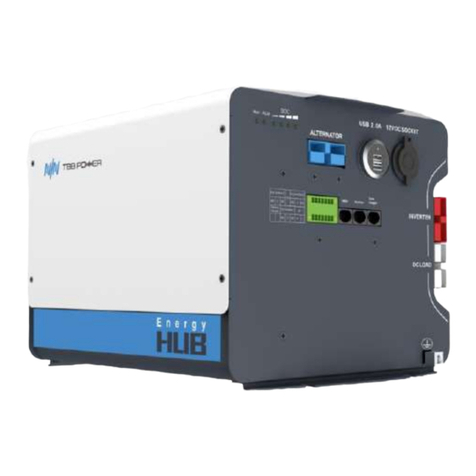
TBB power
TBB power Energy Hub EH128L user manual
